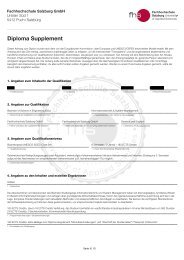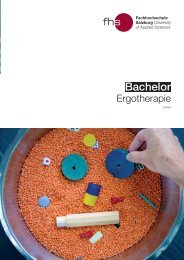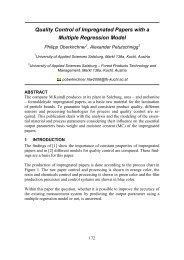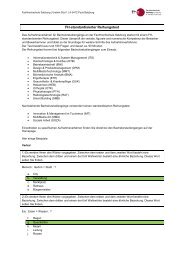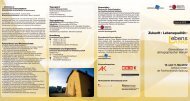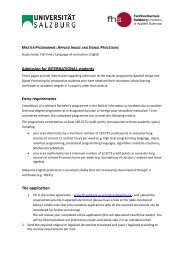Tannin-boron wood preservatives.
Tannin-boron wood preservatives.
Tannin-boron wood preservatives.
Create successful ePaper yourself
Turn your PDF publications into a flip-book with our unique Google optimized e-Paper software.
CIMAD 11 – 1º Congresso Ibero-LatinoAmericano da Madeira na Construção, 7-9/06/2011, Coimbra, PORTUGAL<br />
<strong>Tannin</strong>-<strong>boron</strong> <strong>wood</strong> <strong>preservatives</strong>.<br />
Gianluca Tondi Marie-France Thevenon<br />
Post-doctoral student PhD, Researcher<br />
University of Applied Science- Salzburg(A) CIRAD Persyst – Montpellier (F)<br />
gianluca.tondi@fh-salzburg.ac.at marie-france.thevenon@cirad.fr<br />
Stefanie Wieland Antonio Pizzi<br />
PhD, Head of Research DSc, Professor<br />
University of Applied Science- Salzburg(A) ENSTIB University of Nancy (F)<br />
stefanie.wieland@fh-salzburg.ac.at antonio.pizzi@enstib.uhp-nancy.fr<br />
oto<br />
Keywords – <strong>Tannin</strong>, <strong>boron</strong>, mechanical properties, fire resistance, penetration<br />
ABSTRACT<br />
<strong>Tannin</strong>-<strong>boron</strong> <strong>wood</strong> <strong>preservatives</strong> are alternative products to replace water-borne formulations<br />
based on copper. Interesting results in protection against fungus (pycnoporus sanguineus) were<br />
achieved with formulations based of 20% tannin solutions containing boric acid (Thevenon et al.<br />
2009).<br />
In this paper two upgrades are introduced: extension of preservation properties to soft<strong>wood</strong><br />
species (scots pine) and analysis of the side-properties achieved after treatment.<br />
A detailed study on tannin penetration in beech and scots pine is presented. Microscope analysis<br />
demonstrates that impregnation in scots pine have two preferential directions: Longitudinal through<br />
tracheids and radial through parenchyma rays, while in beech the liquid penetrates the <strong>wood</strong> cell<br />
mainly longitudinally through large and easy accessible vessels.<br />
Commercialization of exterior-door <strong>wood</strong> preservative will be also dependent on the side-properties<br />
derived from the treatment. For this reason, properties such as mechanical resistance and<br />
behavior against fire have been investigated. The mechanical tests have shown a strong<br />
increasing of compression resistance and surface hardness for beech and scots pine samples.<br />
The tests against fire have been monitored considering ignition, flame and ember time. A broad<br />
positive effect on fire-repellence is shown when <strong>wood</strong> is treated with tannin-<strong>boron</strong> formulations.<br />
1
2<br />
CIMAD 11 – 1º Congresso Ibero-LatinoAmericano da Madeira na Construção, 7-9/06/2011, Coimbra, PORTUGAL<br />
1. Introduction<br />
Since creosote has been considered extremely polluting, the market of water-borne <strong>wood</strong><br />
<strong>preservatives</strong> has been dominated by heavy- metal based formulations (CCA, ACQ, ACZA).<br />
Nowadays, in <strong>wood</strong> preservation, more natural products alternative to the commercially available<br />
are required. The use of <strong>boron</strong> combined with tannin resins seems to be a really promising<br />
alternative.<br />
1.1. Boron<br />
Boron compounds like boric acid, borax or disodium octaborate tetrahydrate have proved their<br />
efficiency as <strong>wood</strong> <strong>preservatives</strong> for many years. These compounds have demonstrated to be<br />
highly toxic to fungi and insects (including termites). (Lloyd, 1997; Grace and Yamamoto, 1994).<br />
The high solubility in water of these compounds, allow them to be introduced in <strong>wood</strong> by<br />
conventional methods such as dipping and diffusion or vacuum-pressure treatments (Byrne and<br />
Morris, 1997). Usually, many efforts in research are spent to get solvent-free solutions and in the<br />
case of <strong>boron</strong> its water solubility is definitely a great advantage. This property, however, makes<br />
them unsuitable for weathering because <strong>boron</strong> compounds are easily leached out. Thus, <strong>boron</strong><br />
treated <strong>wood</strong> is useless for outdoor applications without any additional protection (Peylo and<br />
Willeitner, 1997). Nevertheless, <strong>boron</strong> compounds have relatively low toxicity for human beings<br />
(Teshima et al, 2001) and for some animal species (Maier and Knight, 1991). As an active<br />
ingredient of <strong>wood</strong> preservative formulations, boric acid is still eco-toxically and environmentally<br />
acceptable.<br />
Several different methods have already been tried to decrease the leachability of <strong>boron</strong> from <strong>wood</strong><br />
and to use them for exterior and/or ground contact applications (Kartal et al, 2003).<br />
1.2. <strong>Tannin</strong><br />
Polyflavonoid or condensed tannins are natural compounds present in many plants. These<br />
compounds are used by plants as natural <strong>preservatives</strong> against biological attack by insects, fungi<br />
and bacteria (Hagerman et al, 1998). Due to their hydroxy-aromatic chemical composition,<br />
flavonoids are radical scavenger and hence they can be used as UV-ray protective. Furthermore<br />
the high reactivity of these compounds with hardeners (formaldehyde, hexamine, etc.) was the<br />
key-feature for their development in <strong>wood</strong> adhesives (Pizzi et al, 1995; Pichelin et al, 1997). In<br />
these processes the chemical condensation between flavonoids and aldehydes, is catalyzed by<br />
temperature and this kind of activation allows the polymerization to take place “on site”.<br />
The use of mimosa (Acacia Mearnsii formerly Mollissima De Wildt) tannin extract combined with<br />
hexamethylenetetramine (hexamine) as hardener presents two advantages. First is possible to<br />
anchor the tannin in <strong>wood</strong> with a recognized non-formaldehyde-emission compound (Pichelin et<br />
al, 2006, Kamoun et al, 2003) and then the <strong>boron</strong> can be complexed by the flavonoids giving<br />
enough mobility to be active but not enough to be leached out (Pizzi and Baecker, 1996; Thevenon<br />
et al, 2009).<br />
The cross-linked polymer improves the waterproofing of the treated <strong>wood</strong> and hence its durability.<br />
The combination between <strong>boron</strong> and tannin network has already shown surprising results in<br />
EN113 tests that have been done against Pycnoporus sanguineus (strain CTFT 270) (Fig. 1).<br />
Impregnation Solution Weight loss (%) Weight Loss (%)<br />
Control Treated Samples<br />
10% <strong>Tannin</strong> 43,3 33,2<br />
20% <strong>Tannin</strong> 47,4 25,4<br />
10% <strong>Tannin</strong> + H3BO3 45,7 3,42<br />
20% <strong>Tannin</strong> + H3BO3 41,2 3,95<br />
10% <strong>Tannin</strong> + H3BO3 Leached 35,5 1,69<br />
20% <strong>Tannin</strong> + H3BO3 Leached 36,3 1,74<br />
Figure 1- Table of weight loss for treated samples exposed to EN 113 biological test.
CIMAD 11 – 1º Congresso Ibero-LatinoAmericano da Madeira na Construção, 7-9/06/2011, Coimbra, PORTUGAL<br />
The most interesting aspect was that even after leaching the preservation properties of tannin<strong>boron</strong><br />
treated samples were surprisingly high (Thevenon et al, 2009).<br />
The follow-up of this research is divided in two big issues that are both reported in this paper.<br />
First topic is the applicability of this innovative formulation for other kind of <strong>wood</strong> (soft<strong>wood</strong>s), and<br />
the second is the evaluation of the side-properties achieved after the preservation treatment.<br />
2. Material and methods<br />
2.1. Wood Impregnation<br />
Sap<strong>wood</strong> of scots pine (Pinus Sylvestris) and beech (Fagus Sylvatica) pieces of different size<br />
(tailored in accordance with the test to undergo) have been dried for at least one week at 104°C.<br />
These samples have been placed into a desiccator and 8mbar vacuum has been applied to<br />
remove most of the air trapped in the <strong>wood</strong> cells. Afterwards the desiccator has been filled up with<br />
the impregnation solution and pressure has been slowly increased up to environmental pressure.<br />
In accordance with the different kinds of <strong>wood</strong> treated and with the viscosity of the impregnation<br />
solution, different vacuum and impregnation times have been applied.<br />
The weights of the <strong>wood</strong> samples have been gathered before and after the treatment to evaluate<br />
the penetration of the impregnation solution.<br />
The wet samples have been kept for at least 12 hours at 104°C to let the tannin-hexamine resin<br />
harden and then they have been stored in a climatic chamber at 12% moisture content for at least<br />
one week before testing.<br />
<strong>Tannin</strong> impregnation solutions were prepared with 10% to 30% w/w of mimosa extract. The pH of<br />
these solutions was always corrected with a NaOH 50% solution to a pH of 9. 6% by weight of<br />
hexamine as crosslinking agent was added. Boric acid and phosphoric acid (5% by weight) were<br />
also added for the tests against fire.<br />
2.2. Microscope Analysis<br />
Scots pine and beech samples of 20 x 10 x 10 mm treated with a 20% tannin-hexamine resin<br />
have been analysed. Before cutting, the impregnated samples have been softened by boiling. They<br />
have been immersed into a flask of water with few drops of glycerin (defoamer) and were boiled<br />
under reflux for different times according with the hardness of the <strong>wood</strong> species. The slices were<br />
then cut under wet conditions in the three anatomical directions (transversal, radial and tangential)<br />
with a Leica SM 2000 R microtome to a thickness of 10 µm.<br />
2.3. Compression tests<br />
60 x 20 x 20 mm pieces of scots pine and beech treated and untreated have been tested in<br />
compression following the standard DIN 52185. The samples have been tested using a Zwick<br />
/Roell Z 250 universal testing machine with a speed of 2 mm/min.<br />
2.4. Hardness tests<br />
Hardness of scots pine and beech samples have been tested according to the Brinell test<br />
EN1534. The tests have been done with a specific machine for Brinell hardness “emco-test<br />
automatic”.<br />
2.5. Short time fire exposition test<br />
50 x 25 x 15 mm samples of scots pine and beech have been tested against fire. The larger<br />
surface (radial) has been exposed to 100% oxidant flame of a Bunsen burner. The distance<br />
3
4<br />
CIMAD 11 – 1º Congresso Ibero-LatinoAmericano da Madeira na Construção, 7-9/06/2011, Coimbra, PORTUGAL<br />
between Bunsen burner and sample has been kept fix at 2 cm and the burning times have been<br />
controlled with a stop-watch. Ignition, flame and embers time have been recorded for each sample.<br />
Ignition time is the minimum exposition time necessary to let the flame self-burn.<br />
The flame time measures how long the sample keeps the flame after 2 and 3 minutes of continued<br />
exposition. Embers time measures how long it takes the sample to completely extinguishes (no<br />
more red spots, no more fumes).<br />
3. Result and discussions<br />
The effectiveness of <strong>wood</strong> <strong>preservatives</strong> is definitely dependent from the chemical substances<br />
that are involved in the protection towards fungus, bacteria, and insects. The use of <strong>boron</strong> based<br />
preservative instead of heavy metal based formulations will depend mainly from the performances<br />
in durability of both. It has already been proved that <strong>boron</strong> based <strong>preservatives</strong> have strong activity<br />
against fungus and bacteria but their durability does not depend exclusively on this parameters.<br />
Durability is the most important characteristic in <strong>wood</strong> preservation and it depends on several<br />
other aspects such as leaching, fire and scratch resistance.<br />
3.1. Wood penetration<br />
Wood penetration is a side property of every formulation for <strong>preservatives</strong>. Easily penetrating<br />
products allow to protect the <strong>wood</strong> structure more in depth. Massive treated <strong>wood</strong> maintains is<br />
properties longer and can better resist the attack from external agents (rain, sun, biologic attacks,<br />
fire and scratches).<br />
Penetration consists of two aspects: the row uptake of preservative and the amount of solid resin<br />
released.<br />
These two parameters are dependent on the physical and chemical features of the preservative,<br />
the impregnation conditions applied and the anatomy of the <strong>wood</strong> species treated.<br />
The figure shown below (Fig.2) reports the uptake trends in tannin based preservative<br />
penetration and solid resin released in beech and scots pine with fixed impregnation conditions.<br />
Figure 2- Penetration and solid releasing trend for tannin solutions in beech and scots pine.<br />
It can be observed that the tannin solutions with up to 30% s.c. can easily penetrate the beech<br />
samples and the impregnation can be considered complete. <strong>Tannin</strong> solutions of 40% solid content<br />
have high viscosity (around 400 cp) and hence they are not applicable as massive/solid <strong>wood</strong><br />
preservative.
CIMAD 11 – 1º Congresso Ibero-LatinoAmericano da Madeira na Construção, 7-9/06/2011, Coimbra, PORTUGAL<br />
The penetration of beech samples reported in the graphic can be obtained applying 30 minutes<br />
of 8 mbar vacuum and 2 hours of impregnation time at room pressure.<br />
The formulation releases a proportional amount of solid resin and then it is easily possible to<br />
regulate the amount of solid preservative required for each application.<br />
Sap<strong>wood</strong> of scots pine is much more reticent to be impregnated by tannin based formulations.<br />
Even when the impregnation conditions applied are more severe (Vacuum time= 2h; Impregnation<br />
time= 24h) there is a significant decrease of penetration (15%) when 20% of tannin solutions are<br />
applied (Fig. 2). The solid content of 20% of tannin in the impregnation solutions represents the top<br />
threshold for the applicability of tannin formulations in scots pine.<br />
However, it has to be underlined that the penetration obtained with diluted solutions of pine are<br />
also satisfactory because the released amount of solid preservative is still slightly higher than the<br />
respective value for beech. This observation means that in scots pine good performances can be<br />
achieved even when lower amounts of resins are applied.<br />
Considering that scots pine and beech treated with the same formulation, at the same<br />
impregnation condition are not equally impregnated; the only parameter that affects penetration is<br />
their <strong>wood</strong> anatomy.<br />
Porous <strong>wood</strong> like beech presents very large vessels homogenously distributed in the whole <strong>wood</strong><br />
structure. Through these 40-90 µm vessels, which are already used by the living plant to transport<br />
water, the passage of liquid is easy. Good impregnations are achieved even applying smooth<br />
impregnation conditions (Fig.3a).<br />
Conversely, scots pine has a closer structure and the liquid hardly penetrates the <strong>wood</strong> sample.<br />
The impregnation happens in two directions: Longitudinal penetration is ensured by tracheids cells<br />
while radial penetration goes through parenchyma rays (Fig. 3b).<br />
Figure 3- Microscope overview of radial sections of beech and scots pine impregnated with 20% tannin solution.<br />
The <strong>wood</strong> tracheids connected to parenchyma rays are impregnated and it appears that in<br />
late<strong>wood</strong> the penetration is easier.<br />
In terms of dimensions, it is possible to observe that parenchyma´s ray have a diameter of 150-200<br />
µm and hence there is no efforts for tannin to penetrate. Conversely, the vertical penetration is<br />
regulated by pits membrane and is not easy to foresee. These results are also supported by the<br />
penetration studies of these <strong>wood</strong> species made by Scholtz (Scholz et al, 2010).<br />
In consideration of these observations, it is always better to use diluted impregnation solutions<br />
for scots pine samples. This shrewdness allows a deeper and more homogenous distribution of the<br />
<strong>wood</strong> preservative with less drastic impregnation conditions.<br />
A primary role in <strong>wood</strong> penetration is played by the impregnation solutions. Low viscosity tannin<br />
solutions penetrate easier in <strong>wood</strong>. Thus, low concentration of tannin and low polymerization<br />
degree are preferred. These conditions are mandatory for the correct impregnation of <strong>wood</strong><br />
5
6<br />
CIMAD 11 – 1º Congresso Ibero-LatinoAmericano da Madeira na Construção, 7-9/06/2011, Coimbra, PORTUGAL<br />
species that are not easy to penetrate. In some extreme case of penetration (e.g. spruce), heat can<br />
be applied. Temperature, indeed, has a double effect: at the beginning it decreases the viscosity<br />
and activates the tannin-hexamine crosslinking process and so the shelf-life of the formulation<br />
decreases fast.<br />
3.2. Mechanical Properties<br />
Beech and scots pine samples assume a different aspect after tannin-<strong>boron</strong> treatment.<br />
The most apparent changes are the darker color, the smoother surface and the more rigid<br />
aspect. The presence of the tannin-hexamine resins in the <strong>wood</strong>en structure gives a more<br />
consistent aspect to the whole structure.<br />
The quantification of this mechanical property is fundamental to consider the tannin-<strong>boron</strong><br />
formulation applicable to <strong>wood</strong> for exterior grade applications. For this reason, compression test<br />
and hardness measurements have been done.<br />
Figure 4- Compression strength in function of tannin impregnation.<br />
Fig. 4 represents the percentage of strength performance increase in compression resistance<br />
when tannin solutions are cross-linked into the <strong>wood</strong>en structure.<br />
The most immediate result is the general increase of resistance. In case of beech, the penetration<br />
of the tannin formulation is proportional to the concentration of tannin in the impregnation solution.<br />
This information suggests a homogeneous distribution of the resin and explains why the<br />
mechanical properties are proportionally increased. This increasing is significant and takes even<br />
more value considering that beech is around 70% more resistant to compression than scots pine.<br />
Also for treated scots pine samples the resistance to compression increases. The solution of<br />
10% of tannin penetrates deeply and produces a homogeneous distribution of the network after<br />
curing. In this case the mechanical resistance achieved is really high (around 35%).<br />
Unfortunately, when the viscosity of tannin becomes slightly higher, the penetration in scots pine is<br />
not complete and the distribution of the resin is less homogeneous. The mechanical resistance is<br />
still higher, but there is not proportionality between tannin used and strength increase.<br />
Eventually, scots pine can be also reinforced with a tannin-hexamine formulation, but in these<br />
cases lower concentrations are suggested.<br />
Anyways, this increase is always significant and this treatment can be considered not only as an<br />
innovative and eco-friendly solution to increase durability, but also as a method to get the <strong>wood</strong><br />
more resistant for building construction.<br />
Brinell hardness investigates the surface properties of the <strong>wood</strong> samples. Fig. 5 reports on the<br />
trend in surface hardness for beech and scots pine in relation with tannin-hexamine treatments.
CIMAD 11 – 1º Congresso Ibero-LatinoAmericano da Madeira na Construção, 7-9/06/2011, Coimbra, PORTUGAL<br />
Figure 5- Percentage of Brinell hardness increasing in function of tannin impregnation.<br />
Even for this surface phenomenon, the proportionality between hardness and tannin amount in<br />
the impregnation solution is respected only when the penetration is complete. For this reason the<br />
treatment of scots pine with a too concentrated (20%) solution of tannin does not give the expected<br />
results. Notwithstanding that the hardness is a surface property, the overall structure is stressed<br />
and a better hardness is achieved when the samples are homogeneously filled.<br />
Overall, the treated samples always increase their hardness after tannin impregnation treatments<br />
and their resistance to scratch is then upgraded.<br />
3.3. Fire Properties<br />
Another important question for exterior grade <strong>wood</strong> <strong>preservatives</strong> is their behavior against fire.<br />
This characteristic is always studied when the samples have big dimensions to evaluate their<br />
mechanical stability. Unfortunately, big dimension autoclaves are required to impregnate structural<br />
<strong>wood</strong> pieces. Thus, to achieve comparative results, easier lab-scale test have been conducted.<br />
Comparative results for short time exposition tests are reported in Fig. 6.<br />
Parameter<br />
Ember<br />
Time<br />
2 min<br />
(min)<br />
Untreated 12 140 120 4 3,9 12 255 310 9 13<br />
10% <strong>Tannin</strong> 75 35 110 2,5 6 40 60 180 2,5 11<br />
20% <strong>Tannin</strong> 100 22 80 2,5 7 75 15 80 3,5 10<br />
20% <strong>Tannin</strong> +<br />
Boric Acid<br />
20% <strong>Tannin</strong> +<br />
Phosphoric Acid<br />
Scots Pine Beech<br />
Flame Flame Ember Ember<br />
Flame Flame<br />
Ignition Time Time Time Time Ignition Time Time<br />
Time (s)<br />
2 min (s) 3 min (s)<br />
2 min<br />
(min)<br />
3 min<br />
(min)<br />
Time (s)<br />
2 min (s) 3 min (s)<br />
Ember<br />
Time<br />
3 min<br />
(min)<br />
110 25 31 0,8 1,5 60 25 90 0,8 3<br />
120 15 27 0,9 2,5 65 22 80 1 2,8<br />
Figure 6- Table of short time fire tests of scots pine and beech.<br />
Analyzing this table it appears that the effect of tannin decreases the burning properties of<br />
samples. The ignition time significantly increases and the flame extinguishes faster than for the<br />
respective untreated sample.<br />
The application of more concentrated tannin solutions releases more tannin and hence it further<br />
increases the fire resistance properties.<br />
When 20% tannin solutions are applied, the pieces are at least 6 times more difficult to light on and<br />
once they are exposed to 2 minutes of direct flame they stop keeping the flame at least 6 times<br />
before. Also the ember time decreases but in this case the data have to be more carefully<br />
interpreted. After the flame is extinguished the red spots glow very slowly when the <strong>wood</strong> is treated<br />
7
8<br />
CIMAD 11 – 1º Congresso Ibero-LatinoAmericano da Madeira na Construção, 7-9/06/2011, Coimbra, PORTUGAL<br />
with tannins. When the exposition is longer (3 min) the flame penetrated deeper into the sample<br />
and especially for pine this imply a longer ember time.<br />
It has to be reported that especially in the case of beech samples, the hardened tannin resin<br />
modifies the elasticity of the structure. When treated beech is undergone for a long time (>3<br />
minutes) to a flame it has the tendency to suddenly breake up.<br />
The use of inorganic compounds in the formulation increases the fire resistance properties of the<br />
samples. Particular activity is pointed out for the complete extinguish of the sample which becomes<br />
at least twice faster.<br />
This flame retardant action of tannin-furanic copolymer was already known (Tondi et al, 2009).<br />
The fire properties of tannin-hexamine copolymers have never been tested before and these<br />
preliminary tests can suggest some interesting information, also for the <strong>wood</strong> composite industry.<br />
The tannin-<strong>boron</strong> combination, which has already shown very good properties in <strong>wood</strong><br />
preservation, seems to be really interesting also for its flame retardant properties.<br />
4. Conclusions<br />
<strong>Tannin</strong> <strong>boron</strong> <strong>wood</strong> <strong>preservatives</strong> kept the attention of the scientific community for their<br />
impressive properties as fungicide for beech samples. The follow up of this project was to extend<br />
these features to other <strong>wood</strong> species and to study in deep which were the side-properties of this<br />
treatment.<br />
In this work it has been seen that this technology can be applied to scots pine working with more<br />
diluted solutions and taking care of the anatomic characteristics to avoid low penetration.<br />
Mechanical tests have shown that for beech and scots pine, the treatment increases the<br />
compression resistance and hardness of the samples.<br />
Treated beech samples can improve their mechanical properties up to 15% in compression<br />
resistance and up to 50% in hardness with solutions containing 20% of tannin.<br />
For scots pine the best improvements are achieved when 10% tannin solutions are applied. In<br />
these samples, compression resistance increases of 35% while hardness increases of around<br />
25%.<br />
Impregnated <strong>wood</strong> samples exposed to direct flame have shown to be much more fire resistant.<br />
Once the <strong>wood</strong> samples are treated with tannin, the ignition time becomes much longer and the<br />
flame extinguish time much shorter. The use of <strong>boron</strong> and phosphoric acid then break down the<br />
embers time and complete the characteristics of this fire resistant formulation.<br />
All these considerations keep the interest open for the up-scaling of this technology based on<br />
tannin-<strong>boron</strong> synergies.<br />
Before extending this promising technology to a semi-industrial scale, more virulent biological tests<br />
(e.g. termites), stronger condition leaching tests and artificial ageing tests are planned.<br />
Acknowledgements<br />
The authors wish to thank the support of FWF “Lise Meitner” project n.1232-B16.<br />
Bibliographic References<br />
Byrne, A.; Morris, P.I. (1997). “Recent research in <strong>boron</strong> treatment of canadian <strong>wood</strong> species”. 2°<br />
International Conference on Wood Protection with Diffusible Preservatives and Pesticides. Forests<br />
Products Society. 55–61.<br />
Grace, J.K.; Yamamoto, R.T. (1994). “Simulation of remedial borate treatments intended to reduce<br />
attack on Douglas-fir lumber by the Formosan subterranean termites (Isoptera: Rhinotermitidae)”.<br />
Journal of Economic Entomology. 87(6).1547–1554.
CIMAD 11 – 1º Congresso Ibero-LatinoAmericano da Madeira na Construção, 7-9/06/2011, Coimbra, PORTUGAL<br />
Hagerman, A.E.; Riedl, K.M.; Jones, A.G.; Sovik, K.N.; Ritchard, N.T.; Hartzfeld, P.W.; Riechel,<br />
T.L. (1998). “High molecular weight plant polyphenolics (tannins) as biological antioxidants”.<br />
Journal of Agriculture and Food Chemistry. 46 (5). 1887–1892.<br />
Kamoun, C.; Pizzi, A.; Zanetti, M. (2003). “Upgrading of MUF resins by buffering additives – Part 1:<br />
hexamine sulphate effect and its limits”. Journal of Applied Polymer Science. 90(1). 203–214.<br />
Kartal, S.N.; Yoshimura, T.; Imamura, Y. (2003). “Decay and termite resistance of <strong>boron</strong>-treated<br />
and chemically modified <strong>wood</strong> by in situ co-polymerization of allyl glycidyl ether (AGE) with methyl<br />
methacrylate (MMA)”. International Biodeterioration & Biodegradation. 53 (2). 111-117.<br />
Lloyd, J.D. (1997). “International borate status of borate preservative systems.” 2° international<br />
conference on <strong>wood</strong> protection with diffusible <strong>preservatives</strong> and pesticides, Madison, WI, 45–54.<br />
Maier, K.J.; Knight, A.W. (1991). “The toxicity of waterborne <strong>boron</strong> to Daphnia magnia and<br />
Chironomus decorus and the effect of water hardness and sulphate on <strong>boron</strong> toxicity”. Archives of<br />
Environmental Contamination and Toxicology. 20. 282–287.<br />
Peylo, A.; Willeitner, H. (1997). “Leaching of <strong>boron</strong> more than 3 years after exposure”. International<br />
Research Group on Wood Preservation, Stockholm, Sweden. Doc IRG/WP 97-30143.<br />
Pichelin, F.; Kamoun, C.; Pizzi, A. (1997). “Hexamine hardener behaviour: effects on <strong>wood</strong> glueing,<br />
tannin and other <strong>wood</strong> adhesives”. European Journal of Wood and Wood Products. 57 (5). 305–<br />
317.<br />
Pichelin, F.; Nakatani, M.; Pizzi, A.; Wieland, S.; Despres, A.; Rigolet, S. (2006). “Thick <strong>wood</strong><br />
panels bonded industrially with formaldehyde free tannin adhesives”. Forestry Product Journal.<br />
56(5). 31–36.<br />
Pizzi, A.; Meikleham, N.E.; Dombo, B.; Roll, W. (1995). “Autocondensation-based, zero-emission,<br />
tannin adhesives for particleboard”. European Journal of Wood and Wood Products. 53 (1). 201–<br />
204.<br />
Pizzi, A.; Baecker, A.W. (1996). “A new <strong>boron</strong> fixation mechanism for non-toxic <strong>wood</strong><br />
<strong>preservatives</strong>”. Holzforschung. 50(6). 507–510.<br />
Scholz, G.; Krause, A.; Militz, H. (2010). „Exploratory study on the impregnation of scots pine<br />
sap<strong>wood</strong> (pinus sylvestris) and European beech (fagus sylvatica) with different hot melting waxes”<br />
Wood science and technology. 44. 379-388.<br />
Teshima, D.; Taniyama D.; Oishi, R. (2001). “Usefulness of forced diuresis for acute boric acid<br />
poisoning in an adult”. Journal Clinical Pharmacology Therapy. 26. 387–390.<br />
Thevenon, M.F.; Tondi, G.; Pizzi, A. (2009). “High performance tannin resin-<strong>boron</strong> <strong>wood</strong><br />
<strong>preservatives</strong> for outdoor end-uses”. European Journal of Wood and Wood Products. 67. 89-93.<br />
Tondi, G.; Zhao W.; Pizzi, A.; Du, G.; Fierro, V.; Celzard, A. (2009). “<strong>Tannin</strong>-based rigid foams: A<br />
survey of chemical and physical properties”. Bioresource Technology. 100 (21). 5162-5169.<br />
9




